STUDY ON OCEAN CURRENT IN INDIAN OCEAN USING NUMERICAL MODEL
Author affiliations
DOI:
https://doi.org/10.15625/1859-3097/14/3/5157Keywords:
Indian Ocean, ocean currents, ROMS, large Synop vortices.Abstract
OpeNDAP technology (Open-source Project for a Network Data Access Protocol) is used to get access to global data for Indian Ocean region for research. The ocean currents in the Indian Ocean has been computed for many years, results show that: The strong currents exist continuously in Indian Ocean. They flow from west to east that are away from the mainland and in the range from 50S to 50N latitude, and the current near west coast has speed of over 100 cm/s. Also, in many parts of Indian Ocean there are the large synop vortices that have diameter of about hundreds of kilometers, and the speed of vortices is very great, over 100 cm/s. Over time, these vortices do not stay at the same place, but move frequently. The results by using numerical modelling are compared with NASA satellite images and have the correspondence.Downloads
Metrics
References
http://www.myroms.org
http://www.myroms.org">
![]()
Phạm Xuân Dương, 2013. “Mô hình hóa trường dòng chảy tại cửa sông Đồng Bò (Nha Trang) dưới tác động của công trình lấn biển”, Kỷ yếu Hội nghị quốc tế “Biển Đông 2012”, tập 2, tr. 9-16.
![]()
Phạm Xuân Dương, 2012. “Nghiên cứu hoàn lưu vùng vịnh Bình Cang - Nha Trang bằng mô hình số trị”. Luận án tiến sĩ địa lý, Viện khoa học Khí tượng,Thủy văn và Môi trường, Hà Nội.
![]()
Bùi Hồng Long, Phạm Xuân Dương, 2010. “Một số kết quả tính toán dòng chảy theo mùa trong vùng vịnh Bình Cang - Nha Trang bằng mô hình ROMS, Tuyển tập nghiên cứu biển, tập XVII, tr. 30-42.
![]()
Arakawa, A. and V. R. Lamb, 1977. Methods of computational physics, Vol. 17, p. 174-265. Academic Press.
![]()
Arakawa, A., and Lamb, V. R., 1977. Computational design of the basic dynamical processes of the UCLA general circulation model. Methods in computational physics, 17, 173-265.
![]()
Mellor, G. L., and Blumberg, A. F., 1985. Modeling vertical and horizontal diffusivities with the sigma coordinate system. Monthly Weather Review, 113(8): 1379-1383.
![]()
Durran, D. R., 1999. Numerical methods for wave equations in geophysical fluid dynamics (No. 32). Springer.
![]()
Da Silva, A. M., Young-Molling, C. C., and Levitus, S., 1994. Atlas of Surface Marine Data 1994, Vol. 1-5. NOAA Atlas NESDIS, 6-10. U. S. Gov. Printing Office, Washington D.C.
![]()
Marchesiello, P., McWilliams, J. C., and Shchepetkin, A., 2001. Open boundary conditions for long-term integration of regional oceanic models. Ocean modelling, 3(1): 1-20.
![]()
http://earth.nullschool.net/#current/ocean/-surface/currents/equirectangular=-283.96,-47.16,318
http://earth.nullschool.net/#current/ocean/-surface/currents/equirectangular=-283.96,-47.16,318">
![]()









